Leveling the soil is a common job in construction spots and you need to right jumping jack compactor for this. The engine of these rammer works with petrol, diesel or gasoline.
But the main problem is you don’t know which machine to use in which spot. It may be flat soil, or a driveway, or cohesive soil. Where the soil is not hard and has a bit of moisture, the jumping jack does the job well.
On the other hand, a plate compactor is ideal for granular soils, driveways, interlocking paving stones, and compacting asphalt. Moreover, you also need to know which spot you’re leveling. Now, let’s get into these quickly.
Comparison Between Jumping Jack and Plate Compactor
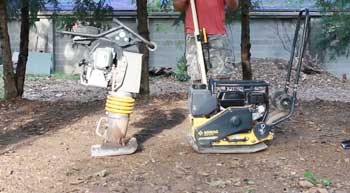
The jumping jack and plate compactor does the same job but on different types of soils. You need to know the differences between these two compactor machines to identify, on which soil you should use them
Check out the following comparison chart below before moving further.
Comparison | Jumping Jack | Plate Compactor |
|---|---|---|
Soil type | Cohesive soil with 13% of moisture. | Granular soil like hard driveway and gravel. |
Weight | Lightweight and compact size. | Heavyweight and large. |
Plate | Small and vibrating | Wide and vibrating |
Holding | Vibration on the handle. | Less vibration on the extra-long handle. |
Finish | Drop some ridges. | Provides a smoother finish. |
Compaction rate | Higher compaction on cohesive soil. | Not as high as jumping jacks. |
Two main things you need to consider while choosing between these compactor machines. The first thing is the type of soil and the second thing is the applicable area. However, you will need more strength to use a jumping jack.
Moreover, you will get comparatively a smoother finish with a plate compactor. Both these machines have a bit of vibration, but the jumping jack has comparatively more.
Why is Jumping Jack Used for?
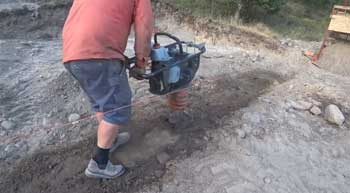
What is a Jumping Jack?
A jumping jack is a soil compactor that comes with a small plate. It runs through diesel or petrol. On tighter spots, it’s the most ideal type of compactor to use. Comparatively, it’s a lightweight and portable one than a plate compactor.
It squeezes the soil and takes out the moisture. Therefore, the machine can compact cohesive soil efficiently.
On which soil a jumping jack is usable?
The main thing you need to ensure before choosing any compactor machine is the soil type. One needs to go for a jumping jack when the compaction is regarding cohesive soil. Cohesive soil means at least 13% moisturized soil.
Again, if you are thinking to provide a perfect finish to the space, it’s never a recommended one. The reason is that jumping jacks have a smaller plate, which drops ridges after compacting the soil.
Therefore, it’s not a suitable one for gravel or hard soils like stone dust. Moreover, you should go for it when the task is in a tighter spot. The compact design makes it a perfect choice for such spots.
What is the compaction rate of a jumping jack?
The compaction rate of the jumping jack stays higher than a plate compactor. Being more powerful, it compacts the soil deeper. For example, you may have up to 1 of compaction through a jumping jack where the plate compactor has 0.5 inches.
Because of the vibrating and quick responsive plate, it drops a huge amount of pressure on the soil. As a result, you can have deeper compaction on normal or cohesive soils.
How Easy It Is To Use A Jumping Jack?
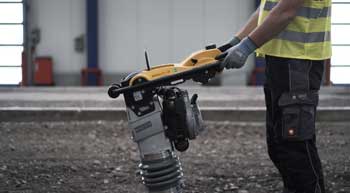
It is the only downgrade of a jumping jack. It’s not immensely hard to handle the compactor machine, but comparatively harder than the plate compactor. The machine requires a bit of strength to get going.
The user needs to hold the handle strongly as it will vibrate all the way during the compaction. Holding it strongly means it will provide stronger and deeper compaction.
Is using jumping jack beneficial
Yes, it is always beneficial to use a jumping jack on cohesive soil. And you know cohesive soil has moisture and the jack squeezes the soil to compact it. Now, here’re reasons why a jumping jack is beneficial.
- The jumping jack works better on tighter spots.
- It provides deeper and stronger compaction of cohesive soil.
- It is a lightweight and easily portable compactor.
- You can get a higher compaction rate through it.
When you need to use a plate compactor
What is a plate compactor?
The compactor machine with a long push handle and a flat, large plate underneath is known as a plate compactor. You can run it using diesel as well as gasoline. Having a wider plate, it’s a bit heavier.
For heavier construction, the compactor is not an easy one to transport. However, having roller wheels underneath can always make it portable. According to the experts, it is recommended to use the compactor in larger areas.
Where to use a plate compactor?
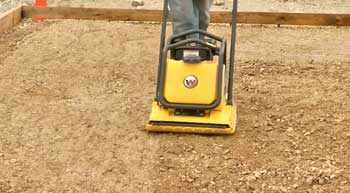
You shouldn’t take it as an ideal compactor for tighter spots; rather go for larger spots where it can reach easily. It is a heavyweight and large compact with high compacting power.
Compared to the jumping jacks, it’s an ideal one to use on driveway or gravel. The reason is the wider plate has a powerful vibration that works on gravel-type soils. It is never recommended to use on cohesive soils.
What is the compaction rate of a plate compactor?
The compaction rate of the plate compactor depends on the type of soil you are using it. Of course, if you know where it is best to use, you won’t head for anywhere else to use it.
Therefore, it can provide up to 1 inch of compaction sometimes. However, the compaction rate still stays lower than jumping jacks’ compaction rate. Jumping jacks always tops the list in terms of compaction.
How easy it is to use a plate compactor?
To be honest, it’s not that difficult to handle a plate compactor compared to a jumping jack. Seeing the size and weight, you may think, it’s the hardest one to control. But after you start the engine, it becomes convenient to handle.
The flat and wide plate doesn’t provide much vibration to the holder’s hand. Therefore, you won’t feel much discomfort and require holding strength.
What are the advantages of using plate compactors
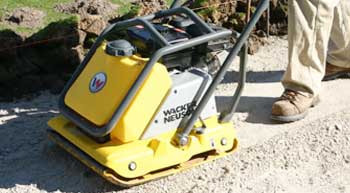
Don’t go for a plate compactor, if you have cohesive soil in the construction spot. However, it can polish and compact the gravel surface efficiently anytime with the wider plate. Here’re the advantages of plate compactors.
- Provides a smoother finish with the wider plate.
- Easy to handle with the long push handle.
- Works well on gravel-type soils.
- It does a good job in larger spots.
- Doesn’t transfer the vibration on the users’ hand.
Final Verdict
Depending on the soil type and area, you need to decide, which one of these compactors is the right one for you. However, going through the above discussion, there should be no more confusion regarding the selection.
Leave a Reply